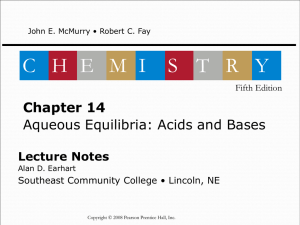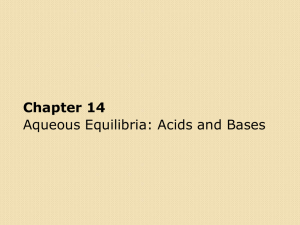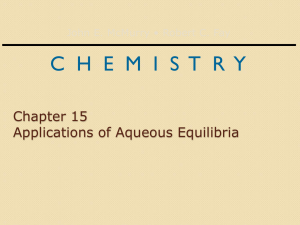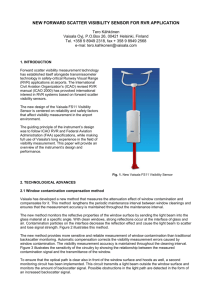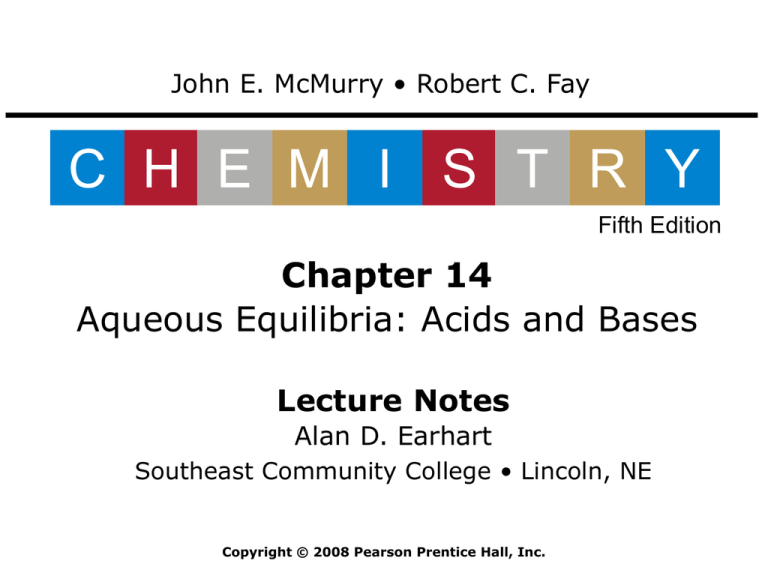
John E. McMurry • Robert C. Fay
C H E M I S T R Y
Fifth Edition
Chapter 14
Aqueous Equilibria: Acids and Bases
Lecture Notes
Alan D. Earhart
Southeast Community College • Lincoln, NE
Copyright © 2008 Pearson Prentice Hall, Inc.
Acid-Base Concepts: The
Brønsted-Lowry Theory
Arrhenius Acid: A substance that dissociates in water
to produce hydrogen ions, H1+.
HA(aq)
H1+(aq) + A1-(aq)
Arrhenius Base: A substance that dissociates in
water to produce hydroxide ions, OH1-.
MOH(aq)
M1+(aq) + OH1-(aq)
Copyright © 2008 Pearson Prentice Hall, Inc.
Chapter 14/2
Acid-Base Concepts: The
Brønsted-Lowry Theory
Brønsted-Lowry Acid: A substance that can transfer
hydrogen ions, H1+. In other words, a proton donor.
Brønsted-Lowry Base: A substance that can accept
hydrogen ions, H1+. In other words, a proton acceptor.
Conjugate Acid-Base Pairs: Chemical species
whose formulas differ only by one hydrogen ion, H1+.
Acid-Base Concepts: The
Brønsted-Lowry Theory
Acid-Dissociation Equilibrium
Hydronium ion = H3O1+
Copyright © 2008 Pearson Prentice Hall, Inc.
Chapter 14/4
Acid-Base Concepts: The
Brønsted-Lowry Theory
Base-Dissociation Equilibrium
Copyright © 2008 Pearson Prentice Hall, Inc.
Chapter 14/5
Acid Strength and Base
Strength
HA(aq) + H2O(l)
Acid
Base
H3O1+(aq) + A1-(aq)
Acid
Base
With equal concentrations of reactants and products,
what will be the direction of reaction?
Stronger acid + Stronger base
Weaker acid + Weaker base
Copyright © 2008 Pearson Prentice Hall, Inc.
Chapter 14/6
Acid Strength and Base
Strength
Weak Acid: An acid that is only partially dissociated in
water and is thus a weak electrolyte.
Hydrated Protons and
Hydronium Ions
HA(aq)
H1+(aq) + A1-(aq)
Due to high reactivity of the hydrogen ion, it is
actually hydrated by one or more water molecules.
[H(H2O)n]1+
n=1
H3O1+
n=2
H5O21+
n=3
H7O31+
n=4
H9O41+
For our purposes, H1+ is equivalent to H3O1+.
Copyright © 2008 Pearson Prentice Hall, Inc.
Chapter 14/9
Dissociation of Water
Dissociation of Water:
2H2O(l)
Ion-Product Constant for Water:
H3O1+(aq) + OH1-(aq)
Kw = [H3O1+][OH1-]
at 25°C: [H3O1+] = [OH1-] = 1.0 x 10-7 M
Kw = (1.0 x 10-7)(1.0 x 10-7) = 1.0 x 10-14
Dissociation of Water
Kw = [H3O1+][OH1-] = 1.0 x 10-14
-14
1.0
x
10
[H3O1+] =
[OH1-]
-14
1.0
x
10
[OH1-] =
[H3O1+]
Copyright © 2008 Pearson Prentice Hall, Inc.
Chapter 14/11
Dissociation of Water
The pH Scale
pH =
-log[H3O1+]
[H3O1+]
= 10
-pH
Basic solution: pH > 7
Neutral solution: pH = 7
Acidic solution: pH < 7
Copyright © 2008 Pearson Prentice Hall, Inc.
Chapter 14/13
The pH Scale
The hydronium ion concentration for lemon juice is
approximately 0.0025. What is the pH when
[H3O1+] = 0.0025 M?
2 significant figures
pH = -log(0.0025) = 2.60
2 decimal places
Copyright © 2008 Pearson Prentice Hall, Inc.
Chapter 14/14
The pH Scale
Calculate the pH of an aqueous ammonia solution
that has an OH1- concentration of 0.0019 M.
-14
-14
1.0
x
10
1.0
x
10
-12 M
[H3O1+] =
=
=
5.3
x
10
[OH1-]
0.0019
pH = -log(5.3 x 10-12) = 11.28
Copyright © 2008 Pearson Prentice Hall, Inc.
Chapter 14/15
The pH Scale
Acid rain is a matter of serious concern because most
species of fish die in waters having a pH lower than 4.55.0. Calculate [H3O1+] in a lake that has a pH of 4.5.
[H3O1+]
= 10
-4.5
= 3 x 10-5 M
Copyright © 2008 Pearson Prentice Hall, Inc.
Chapter 14/16
Measuring pH
Acid-Base Indicator: A substance that changes color
in a specific pH range. Indicators exhibit pH-dependent
color changes because they are weak acids and have
different colors in their acid (HIn) and conjugate base
(In1-) forms.
HIn(aq) + H2O(l)
H3O1+(aq) + In1-(aq)
Color A
Copyright © 2008 Pearson Prentice Hall, Inc.
Color B
Chapter 14/17
Measuring pH
Copyright © 2008 Pearson Prentice Hall, Inc.
Chapter 14/18
The pH in Solutions of Strong
Acids and Strong Bases
What is the pH of a 0.025 M solution of HNO3?
100%
HNO3(aq) + H2O(l)
H3O1+(aq) + NO31-(aq)
Since HNO3 is a strong acid, [H3O1+] = [HNO3].
pH = -log([H3O1+]) = -log(0.025) = 1.60
Copyright © 2008 Pearson Prentice Hall, Inc.
Chapter 14/19
The pH in Solutions of Strong
Acids and Strong Bases
What is the pH of a 0.025 M solution of NaOH?
NaOH(aq)
Na1+(aq) + OH1-(aq)
Since NaOH is a strong base, [OH1-] = [NaOH].
-14
-14
1.0
x
10
1.0
x
10
-13 M
[H3O1+] =
=
=
4.0
x
10
[OH1-]
0.025
pH = -log([H3O1+]) = -log(4.0 x 10-13 ) = 12.40
Copyright © 2008 Pearson Prentice Hall, Inc.
Chapter 14/20
Equilibria in Solutions of Weak
Acids
HA(aq) + H2O(l)
H3O1+(aq) + A1-(aq)
Acid-Dissociation Constant: Ka =
Copyright © 2008 Pearson Prentice Hall, Inc.
[H3O1+][A1-]
[HA]
Chapter 14/21
Equilibria in Solutions of Weak
Acids
The pH of 0.250 M HF is 2.036. What are the values
of Ka and pKa for hydrofluoric acid?
HF(aq) + H2O(l)
H3O1+(aq) + F1-(aq)
I
0.250
≈0
0
C
-x
+x
+x
E
0.250 - x
x
x
x = [H3O1+] = 10-2.306 = 0.00920 M
Copyright © 2008 Pearson Prentice Hall, Inc.
Chapter 14/23
Equilibria in Solutions of Weak
Acids
Ka =
[H3O1+][F1-]
[HF]
[F1-] = [H3O1+] = 0.00920 M
[HF] = 0.250 - x = 0.250 - 0.00920 = 0.241 M
Ka =
[H3O1+][F1-]
[HF]
(0.00920)(0.00920)
=
0.241
= 3.51 x 10-4
pKa = -log(Ka) = -log(3.51 x 10-4) = 3.455
Copyright © 2008 Pearson Prentice Hall, Inc.
Chapter 14/24
Calculating Equilibrium
Concentrations for Weak Acids
Calculate the pH of a 0.10 M HCN solution. At 25 °C,
Ka = 1.4 x 10-9.
HCN(aq) + H2O(l)
H3O1+(aq) + CN1-(aq)
I
0.10
≈0
0
C
-x
+x
+x
E
0.10 - x
x
x
Ka =
[H3O1+][CN1-]
[HCN]
Copyright © 2008 Pearson Prentice Hall, Inc.
Chapter 14/25
Calculating Equilibrium
Concentrations for Weak Acids
4.9 x 10-10 =
(x)(x)
(0.10 - x)
≈
x2
0.10
x = [H3O1+] = 7.0 x 10-6 M
pH =-log([H3O1+]) = -log(7.0 x 10-6) = 5.15
Copyright © 2008 Pearson Prentice Hall, Inc.
Chapter 14/26
Percent Dissociation in
Solutions of Weak Acids
[HA] dissociated
Percent dissociation =
x 100%
[HA] initial
Polyprotic Acids
H2CO3(aq) + H2O(l)
Ka1 =
[H3O1+] [HCO31-]
[H2CO3]
HCO31-(aq) + H2O(l)
Ka2 =
H3O1+(aq) + HCO31-(aq)
H3O1+(aq) + CO32-(aq)
[H3O1+] [CO32-]
[HCO31-]
= 4.3 x 10-7
= 5.6 x 10-11
Copyright © 2008 Pearson Prentice Hall, Inc.
Chapter 14/29
Polyprotic Acids
Copyright © 2008 Pearson Prentice Hall, Inc.
Chapter 14/30
Polyprotic Acids
Calculate the pH of a 0.020 M H2CO3 solution. At
25 °C, Ka1 = 4.3 x 10-7.
H2CO3 (aq) + H2O(l)
H3O1+(aq) + HCO31-(aq)
I
0.020
≈0
0
C
-x
+x
+x
E
0. 20 - x
x
x
Ka1 =
[H3O1+][HCO3 1-]
[H2CO3]
Copyright © 2008 Pearson Prentice Hall, Inc.
Chapter 14/31
Polyprotic Acids
4.3 x 10-7 =
(x)(x)
(0.020 - x)
≈
x2
0.020
x = [H3O1+] = 9.3 x 10-5 M
pH =-log([H3O1+]) = -log(9.3 x 10-5) = 4.03
Copyright © 2008 Pearson Prentice Hall, Inc.
Chapter 14/32
Equilibria in Solutions of Weak
Bases
B(aq) + H2O(l)
BH1+(aq) + OH1-(aq)
Base
Acid
Acid
Base
[BH1+][OH1-]
Base-Dissociation Constant: Kb =
NH3(aq) + H2O(l)
Kb =
[B]
NH41+(aq) + OH1-(aq)
[NH41+][OH1-]
[NH3]
Copyright © 2008 Pearson Prentice Hall, Inc.
Chapter 14/33
Equilibria in Solutions of Weak
Bases
Copyright © 2008 Pearson Prentice Hall, Inc.
Chapter 14/34
Equilibria in Solutions of Weak
Bases
Calculate the pH of a 0.40 M NH3 solution. At 25 °C,
Kb = 1.8 x 10-5.
NH3(aq) + H2O(l)
NH41+(aq) + OH1-(aq)
I
0.40
0
≈0
C
-x
+x
+x
E
0.40 - x
x
x
Kb =
[NH41+][OH1-]
[NH3]
Copyright © 2008 Pearson Prentice Hall, Inc.
Chapter 14/35
Equilibria in Solutions of Weak
Bases
1.8 x 10-5 =
(x)(x)
(0.40 - x)
≈
x2
0.40
x = [OH1-] = 0.0027 M
-14
1.0
x
10
[H3O1+] =
= 3.7 x 10-12 M
0.0027
pH =-log([H3O1+]) = -log(3.7 x 10-12) = 11.43
Copyright © 2008 Pearson Prentice Hall, Inc.
Chapter 14/36
Relation Between Ka and Kb
NH41+(aq) + H2O(l)
H3O1+(aq) + NH3(aq)
Ka
NH3(aq) + H2O(l)
NH41+(aq) + OH1-(aq)
Kb
H3O1+(aq) + OH1-(aq)
Kw
2H2O(l)
Ka x Kb =
[H3O1+][NH3]
[NH41+]
x
[NH41+][OH1-]
[NH3]
= [H3O1+][OH1-] = Kw
= (5.6 x 10-10)(1.8 x 10-5) = 1.0 x 10-14
Copyright © 2008 Pearson Prentice Hall, Inc.
Chapter 14/37
Relation Between Ka and Kb
Ka x Kb = Kw
conjugate acid-base pair
Ka =
Kw
Kb
Kb =
Kw
Ka
pKa + pKb = pKw = 14.00
Copyright © 2008 Pearson Prentice Hall, Inc.
Chapter 14/38
Acid-Base Properties of Salts
Salts That Yield Neutral Solutions
The following ions do not react appreciably with water
to produce either H3O1+ or OH1- ions:
•
Cations from strong bases:
• Alkali metal cations of group 1a (Li1+, Na1+, K1+)
• Alkaline earth metal cations of group 2a
(Ca2+, Sr2+, Ba2+), except for Be2+
•
Anions from strong monoprotic acids:
• Cl1-, Br1-, I1-, NO31-, and ClO41Copyright © 2008 Pearson Prentice Hall, Inc.
Chapter 14/39
Acid-Base Properties of Salts
Salts That Yield Acidic Solutions
Salts such as NH4Cl that are derived from a weak base
(NH3) and a strong acid (HCl) yield acidic solutions.
NH41+(aq) + H2O(l)
H3O1+(aq) + NH3(aq)
Ammonium ion (NH41+) is the conjugate acid of the
weak base ammonia (NH3) while chloride ion (Cl1-) is
neither acidic nor basic.
Copyright © 2008 Pearson Prentice Hall, Inc.
Chapter 14/40
Acid-Base Properties of Salts
Salts That Yield Acidic Solutions
Hydrated cations of small, highly charged metal ions,
such as Al3+.
Acid-Base Properties of Salts
Salts That Yield Acidic Solutions
Hydrated cations of small, highly charged metal ions,
such as Al3+.
Acid-Base Properties of Salts
Salts That Yield Basic Solutions
Salts such as NaCN that are derived from a strong
base (NaOH) and a weak acid (HCN) yield basic
solutions.
CN1-(aq) + H2O(l)
HCN(aq) + OH1-(aq)
Cyanide ion (CN1-) is the conjugate base of the weak
acid hydrocyanic acid (HCN) while sodium ion (Na1+) is
neither acidic nor basic.
Copyright © 2008 Pearson Prentice Hall, Inc.
Chapter 14/43
Acid-Base Properties of Salts
Salts That Contain Acidic Cations and Basic Anions
The pH of an ammonium carbonate solution, (NH4)2CO3,
depends on the relative acid strength of the cation and
the relative base strength of the anion.
Is it acidic or basic?
Copyright © 2008 Pearson Prentice Hall, Inc.
Chapter 14/44
Acid-Base Properties of Salts
Salts That Contain Acidic Cations and Basic Anions
(NH4)2CO3:
NH41+(aq) + H2O(l)
H3O1+(aq) + NH3(aq)
Ka
CO32-(aq) + H2O(l)
HCO31-(aq) + OH1-(aq)
Kb
Three possibilities:
• Ka > Kb: The solution will contain an excess of
H3O1+ ions (pH < 7).
• Ka < Kb: The solution will contain an excess of
OH1- ions (pH > 7).
• Ka ≈ Kb: The solution will contain approximately
equal concentrations of H3O1+ and OH1- ions
(pH ≈ 7).
Copyright © 2008 Pearson Prentice Hall, Inc.
Chapter 14/45
Acid-Base Properties of Salts
Salts That Contain Acidic Cations and Basic Anions
(NH4)2CO3:
NH41+(aq) + H2O(l)
H3O1+(aq) + NH3(aq)
Ka
CO32-(aq) + H2O(l)
HCO31-(aq) + OH1-(aq)
Kb
Ka for NH41+ =
Kb for CO32- =
Kw
Kb for NH3
1.0 x 10-14
=
Kw
Ka for HCO31-
1.8 x 10-5
= 5.6 x 10-10
1.0 x 10-14
=
= 1.8 x 10-4
5.6 x 10-11
Basic, Ka < Kb
Copyright © 2008 Pearson Prentice Hall, Inc.
Chapter 14/46
Acid-Base Properties of Salts
Copyright © 2008 Pearson Prentice Hall, Inc.
Chapter 14/47
Factors That Affect Acid
Strength
Bond Strength
Factors That Affect Acid
Strength
Bond Polarity
Copyright © 2008 Pearson Prentice Hall, Inc.
Chapter 14/49
Factors That Affect Acid
Strength
Oxoacids
Copyright © 2008 Pearson Prentice Hall, Inc.
Chapter 14/50
Factors That Affect Acid
Strength
Oxoacids
Copyright © 2008 Pearson Prentice Hall, Inc.
Chapter 14/51
Lewis Acids and Bases
Lewis Acid: An electron-pair acceptor.
Lewis Base: An electron-pair donor.
Copyright © 2008 Pearson Prentice Hall, Inc.
Chapter 14/52
Lewis Acids and Bases
Lewis Acid: An electron-pair acceptor.
Lewis Base: An electron-pair donor.
Copyright © 2008 Pearson Prentice Hall, Inc.
Chapter 14/53

